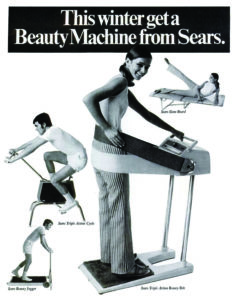We all love a quick fix, including when it comes to our bodies. It seems to me we’re especially vulnerable to exercise gimmicks around the holidays, when our routines are disrupted, and at the New Year, when we want to start over again.
When you look back on the fads, you can’t help but laugh: sauna suits promised to help you sweat away the pounds while you lounged around the house; “exercise sandals” promised to tone your legs; and a machine with a vibrating belt could allegedly jiggle away the fat.

Ridiculous as those fads seem now, most of us have fallen for one or two. I have a friend, someone who wishes to remain nameless, who admits to having owned the Ab Roller. Dawn Rickman remembers the belly dancing craze, and she danced for a couple of years. My mom had the Richard Simmons “Sweating to the Oldies” on VHS. My sister bought the Thighmaster. I’m not judging, of course — even an exercise professional has skeletons in her workout closet. But let’s not go there.
The thing to know is that fitness, besides being something to strive for, is also an industry. And the fitness industry thrives on change. That’s not all bad, because new developments can create positive changes in our ways of exercising. One example: the growing popularity of working on core strength. Another: the new ways that we use simple technologies to help us engage in and monitor our workouts.
One thing to look for when considering trends is whether they really are based on evolving science and improved technology. To take the core strength example, studies of human performance and fitness have taught us that more core strength translates to lower injury risk and improved athletic performance. It’s important to be careful about the sources you consider; one I turn to at times is the Harvard Medical School site, where, for example, you can find a whole section on how to choose fitness equipment.
I like to talk with my primary care provider about exercise trends — she’s very up on things. Your doctor can help you keep your medical history in mind as you consider new routines.
The latest craze isn’t driven by science, but by viral internet videos or celebrity endorsements.
So, if you’re thinking about trying something new or buying a piece of equipment for a new you in the New Year, how can you discern the hype from the legitimate? Before you jump on the latest bandwagon, ask yourself these four questions to put your wishful thinking to the test:
-

Sauna suits were supposed to melt off excess pounds. Is this thing promising fabulous results with little or no effort? If it sounds too good to be true, then it is. There is no way to get a flat belly or defined deltoids without breaking a sweat.
- Is it promising fast results? Sorry to be the bearer of bad news, but physical changes such as increased muscle definition or permanent weight loss take months.
- Is it focused on only one thing? These one-trick ponies that address only one movement or muscle group aren’t enough to improve your overall fitness.
- Is it being hawked by an actor, actress, or reality TV star? Is it promoted through late-night infomercials? This should set off the alarm bells right away.
The worst of the fads may lead to injuries — I know the high intensity kick boxing videos did some harm. But more often, the problem is that these fads just don’t do any good. Aside from the benefit of laughter.
And, I’ll admit, some fads have done some good. Laugh if you will, but Richard Simmons taught a generation of middle-aged women that exercise could be fun. And those Dr. Scholl’s wooden sandals? I don’t think they toned the calf muscles as promised, but for us children of the ’70s, at least they gave us a way to know when mom was coming down the hall!



